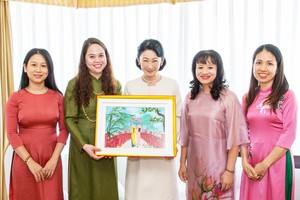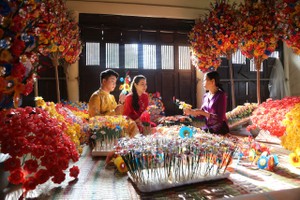For Vietnamese people, no holiday is as significant as Tet. It's an occasion for family reunions, for worshipping the ancestors, for taking a once-a-year rest – and for preserving the old values.

What are these ‘old values'? They are the customs for Tet that have been transferred from generation to generation.
Obtaining new items for Tet is one example. One wants as many new things as possible, including clothing, jewellery, electronic devices, bikes and even houses.
Obtaining a new item ahead of Tet yields double or triple happiness.
Since one can't buy a new house every year, people often repaint their houses for Tet, or at least tidy them and decorate them with flowers. This creates high demand for flowers, helping to preserve traditional villages growing flowers.
Culturally, the most important part of Vietnamese spiritual life is ancestor worship. Tet is for the dead as well as the living, so even those who cannot afford home decorations must purchase decorations for home altars and worshipping places.
The bustling air of traditional craft and flower villages provides a good view of Vietnamese artisanship and flowers, especially in Hue, which has been praised for its conservation of these remnants of the past. If you get the chance to visit Hue at this time, Tien Non Village should be your first destination. Take a 4km ride on a bicycle or motorbike downstream along the Huong River, and you'll reach a field of colours.
Tien Non was formed in the 16th century and villagers have kept the tradition of flower growing alive since then. Flowers are planted individually in the gardens of every home in the village in addition to the common field where 20 prominent farmers joined to form a co-operative.
There, locals grow different varieties of daisies, lilies, orchids and tulips as well as local flowers. You can walk around to breathe fresh air and take photos with the colourful flowers or bring some back to Hue.
The villagers these days are busy selecting flowers to sell ahead of Tet. Many city dwellers come here to buy flowers, expecting more choice and lower prices. The chance to view the flower field remains after Tet, as more than half the flowers on this 10,000sq.m area will be reserved for rituals after the holiday, according to Duong Thong, the co-operative's deputy head.
Adjacent to Tien Non is Thanh Tien Village, where people produce paper flowers for rituals. Every home in Viet Nam has an altar for the kitchen gods and almost half of the population has altars for Mau, the Mother Goddess. Paper flowers from Thanh Tien decorate this type of altar.
Created in the 16th century, paper flowers were the main Tet decoration for altars before fresh flowers became easier to grow and purchase.
Village artisan Pham Loan said production began two months ago with bamboo processing and paper dyeing. His family produced 1,000 branches this year. Each branch has around seven flowers that resemble wild blossoms.
Go about one kilometre downstream from the village, and you'll reach another village producing ritual items: Sinh Village, devoted to paper painting.
Locals said production would continue until the last day of the lunar year.
"Each family produces one kind of ritual paper. I make paper printed with cattle while others print paper with humans," said villager Le Quang Dich.
Vietnamese people in the old days burnt votive paper printed with pigs, cows and buffalo as substitutes for their cattle, asking the gods not to take away the animals in their sheds. The tradition remains alive today as many homes in the rural areas raise pigs and cows in their home gardens and the burning is believed to make business smooth.
Artisans create the paintings by using a wood block to ink dark colour on a sheet of paper, then adding more paint to make them colourful. Millions of paper sheets have been produced for Tet since lunar October.
Visitors can see the artistic side of the craft at the workshop of local artisan Ky Huu Phuoc, who has attempted to make the craft new in modern life. Visitors can sit under a bamboo hut and sip fresh green tea with ginger free of charge.
Many think preparations for Tet are more fun than the actual holiday, because of the attempt to create a perfect Tet and the sensation of excitement about the coming spring and the new year. For those who are fond of Vietnamese culture, to be in Hue at this time visiting the villages is a great chance to smell Tet.
























